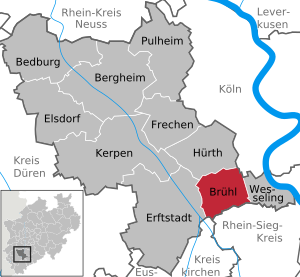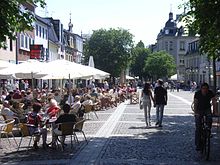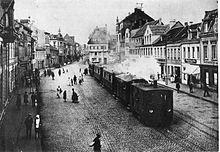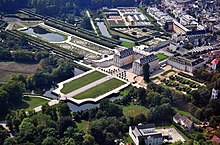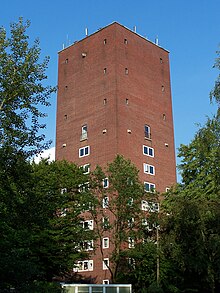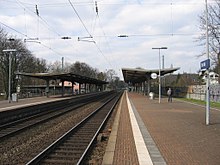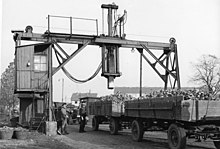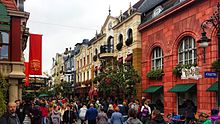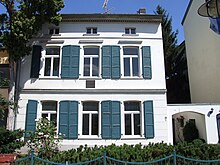Bruehl (Rhineland)
| coat of arms | Germany map | |
|---|---|---|
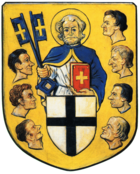
|
Coordinates: 50 ° 50 ' N , 6 ° 54' E |
|
| Basic data | ||
| State : | North Rhine-Westphalia | |
| Administrative region : | Cologne | |
| Circle : | Rhein-Erft district | |
| Height : | 65 m above sea level NHN | |
| Area : | 36.12 km 2 | |
| Residents: | 44,126 (Dec. 31, 2019) | |
| Population density : | 1222 inhabitants per km 2 | |
| Postal code : | 50321 | |
| Area code : | 02232 | |
| License plate : | BM | |
| Community key : | 05 3 62 012 | |
| LOCODE : | DE BRU | |
| City structure: | 7 districts | |
City administration address : |
Uhlstrasse 3 50321 Brühl |
|
| Website : | ||
| Mayor : | Dieter Freytag ( SPD ) | |
| Location of the city of Brühl in the Rhein-Erft district | ||
Brühl is a medium-sized city in the Rhein-Erft district in North Rhine-Westphalia and part of the Rhine-Ruhr metropolitan region , a metropolitan area with almost ten million inhabitants. Thanks to the World Heritage appointed Augustusburg and Falkenlust , the surge Schallenburg , the Ville lakes within the Kotte Forst and the Phantasialand theme park, it is one of the main tourist destinations in the Rhineland . With its numerous universities , museums , art galleries , local authorities and manufacturing companies , the former electoral residence is also an important regional center between Cologne and Bonn .
Districts
The city center ( shown as Centrum on Brühl signposts ) largely corresponds to the core town of the same name, which is divided into Brühl-Mitte , Brühl-Nord , Brühl-Ost , Brühl-Süd and Brühl-West . The two localities Eckdorf and Geildorf also belong to the Badorf district to the south . In total, Brühl consists of seven districts combined for statistical standardization:
| district | Population (2019) |
|---|---|
| Downtown | 24,133 |
| Badorf | 6.152 |
| pagan | 1,371 |
| Kierberg | 4,283 |
| Pingsdorf | 4,768 |
| Schwadorf | 1,598 |
| Vochem | 4,912 |
| total | 47,217 |
geography
Geographical location
Brühl is located in the Cologne bay , more precisely on the Brühl Lössplatte - a loess -covered central patio plate between the northwest and the north of Bonn Hürths - at the foot of the promontory and at the edge of Ville that the Rhineland Nature Park belongs. The closest major cities are Cologne and Bonn. Cologne is directly adjacent to the Meschenich district in the north-east of Brühl, while the city of Bornheim lies in the south between Brühl and Bonn . Looking clockwise from the north, all of the municipalities bordering Brühl are Hürth, Cologne, Wesseling , Bornheim, Weilerswist and Erftstadt . The highest point in the urban area is at 154.8 m above sea level. NHN in the Ville south of the Birkhof , the lowest at 56 m above sea level. NHN at the exit of the Palmersdorfer Bach on the Wesselingen urban area; which is located on a hill southwest of the city center of Brühl at a good 125 m above sea level. The water tower Gabjeiturm , located at NHN , reaches a height of 174.3 m above sea level. NHN .
Climate and soil
The mild climate of the Cologne Bay prevails in Brühl. This is in the transition zone from the temperate maritime climate to the continental climate with mild winters (January mean around 2 to 3 ° C) and moderately warm summers (July mean around 18 to 19 ° C). The entire city area is protected by the Eifel Barrier in the lee of the westerly winds and is therefore climatically favored. Occasionally, however, foehn weather conditions can develop. Slope rain is mainly responsible for the comparatively low rainfall of 681 millimeters per year. In addition to the climate, the deep loess soil in particular has favored the creation of large fruit and vegetable growing areas around Brühl.
history
Prehistoric traces
People probably lived in what is now the urban area as early as the Neolithic Age . Finds of post pits and wall ditches at Bonnstrasse 200 as well as pits with municipal waste and water drainage pits, which have similarities with the ceramic settlement site in Arnoldsweiler , bear witness to this.
Three circular graves near the young age settlement site, as well as a vessel that has broken into pieces, indicate settlement in the Bronze Age . Furthermore, post pits for buildings with six or eight posts at the aforementioned point as well as ceramic shards indicate settlement in the Iron Age .
Roman traces in Brühl
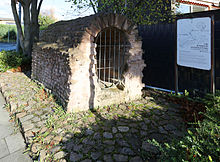
In antiquity, Roman state roads ran through today's urban area. These connected the first Roman estates in Brühl, dated to the middle of the 1st century, with the nearby Colonia and Bonna, which was also not far away . A little later, the Eifel aqueduct , a Roman aqueduct to supply the city of Cologne with drinking water, was built . The long-distance road from Cologne to Trier and today's Bonnstraße were Roman roads , the latter of which is now known as the Roman road. Additions from Roman graves and other artifacts as well as ancient relics excavated in the city are kept in the Rheinisches Landesmuseum in Bonn. Settlement of the Brühl region in Roman times is therefore undisputed.
The route of the Roman Canal ran roughly from today's Waldorf district, which belongs to the neighboring Bornheim, with little incline in the level of the Villerücken and then through the Walberberg district over the eastern slope of the foothills through today's urban area of Brühl. No traces of the original Roman Eifel aqueduct have been preserved along the route. In the Badorf district of Brühl on the former Steinweg, the forerunner of the later Köln-Bonner Straße, not only remains of the Roman wall but also well-preserved parts of the Eifel aqueduct are said to have been uncovered, whose whereabouts are unknown.
In the inner city of Brühl itself there are no traces of Roman times, as the area between today's railway line in the east and the Roman road in the west was originally an inhospitable forest and swamp landscape. The Römerhof housing estate in Brühl has no relation to a former Roman vicus , as is the case with the Römerhof Brenig . The urban construction project from the 1920s in the west of the city center of Brühl is only reminiscent of the Eifel pipeline that formerly ran below the settlement. Likewise, the Cologne-Bonner Landstrasse in front of the city, leading to the south (it is known as the Alte Heerstrasse and Römerstrasse), is officially the Römerstrasse in Brühl. In the 1950s, another residential area was built on Römerstrasse. It is just before the road to Pingsdorf , and the road that leads into it was named “Am Römerkanal”. As they did not have their own exhibit of the ancient aqueduct, the city acquired a section of the Roman Canal that was exposed in Breitenbenden in 1979 and set it up in the new settlement on the roadside. Relics of the Roman Canal have not yet been found, however, as the masonry pipe was often removed and reused as masonry that was otherwise unavailable in the vicinity, for example in the foundation walls of the castle.
In 1959, two coffins lying next to each other were uncovered in Römerstrasse in Vochem. The sarcophagi , including a lead coffin , could be dated to the late 3rd century by the archaeologist Waldemar Haberey . The stone coffin consisted of reused parts that had originally served as the base of a statue of the future emperor Pertinax . Later, in May 1972, part of a Roman burial ground was uncovered during construction work on the gymnasium in Sankt-Albert-Strasse. Six burials with additions from the late 3rd and first half of the 4th century were found in Sankt-Albert-Straße. Cremation grave 3 is in an ash box , another cremation grave (grave 4) was surrounded with brick panels. Of the four body burials, grave 5 is a tuff stone coffin with skeletal remains of a woman who has reached the age of over 70 years. Grave 1 and probably also grave 5 are lead coffins, grave 2 is a wooden coffin.
middle Ages
The first documented mentions of courtyards in today's urban area come from around the year 650. Badorf and Pingsdorf ceramic vessels from the early Middle Ages are among the most important Rhenish cultural assets. The Palmersdorfer Hof is mentioned in a deed of donation from Archbishop Brun of Cologne for the St. Cäcilien Abbey in Cologne from 961.
The name Brühl first appears on a document in 1180, when Archbishop Philipp von Heinsberg combined two of the courtyards to form the courtyard on the Brule . The name follows from an old German word that means the location in a swampy valley. The town of Bröhl is named within the Ripuarian dialect spoken in the Cologne Bay .
Since the Cologne archbishops and electors (the Cologne archbishops were at that time, as in Mainz and Trier, electors at the same time) were not welcomed in Cologne at this time, Brühl became their preferred place of residence. In 1284 Archbishop Siegfried von Westerburg built a moated castle against the city of Cologne in Brühl, which was completed in 1290. He finally granted Brühl city rights in 1285 and at the same time transferred self-administration and jurisdiction to the council of lay judges under city law. The city was developed into one of the strongest state fortresses in Kurköln and the seat of the bailiff of the Brühl office . In 1469, Elector Ruprecht von der Pfalz also officially elevated Brühl to the state capital of Kurköln.
In 1530, Brühl was almost completely destroyed by fire. This is one of the reasons why Bonn became the seat of the Cologne state government from 1567 onwards. However, the elector himself continued to reside in Brühl during the summer months.
17th and 18th centuries
From the Thirty Years War to the French Revolution

In 1596 four women from Brühl were victims of witch hunts . Their fate shared in 1604 the 35-year-old maid Anna Schmitz, who was tortured in a "witch trial" and then burned.
During the Thirty Years' War , the electoral archbishop of Cologne , Ferdinand of Bavaria, met with allies of the Catholic League at Brühl Castle. In 1647 Hessian troops plundered the city before the Peace of Munster ended the war the following year . Between 1666 and 1667 Brühl was ravaged by the plague . The following year the Franciscans built their first hospital on Uhlstrasse. In 1689, Kurköln and with it Brühl and its castle were drawn into armed conflicts between the Holy Roman Empire and the States General , the Mark Brandenburg , the Principality of Calenberg and the Diocese of Münster , which was allied with King Louis XIV of France. The dispute, which began as the War of the Palatinate Succession , had its local significance through disputes over the succession of Archbishop Maximilian Heinrich von Bayern , who died in 1688, which Wilhelm Egon von Fürstenberg sought with French help. The French had holed up in the electoral palace. The imperial troops, besieging this since June 1689, shot the powder tower of the castle into the air with a Münster battery . The city was then handed over in August and the city walls then razed by the Hanoverians. As a result, Brühl was no longer a fortified city in the future.
The long war weakened the imperial power, but let the German princes gain further strength. They wanted to represent themselves brilliantly after the example of the French absolutist kings. In 1725, Elector Clemens August von Bayern laid the foundation stone for Augustusburg Castle on the site of the destroyed castle. In 1735 the church of the neighboring Franciscan monastery was redesigned in the baroque style to the castle church from 1493 and connected to the castle by an orangery . In 1763 Wolfgang Amadeus Mozart , his father and his sister went on the first major tour of Brühl, during this short visit the seven-year-old child prodigy played on the organ of the castle church.
The heyday of the electors and archbishops in Brühl ended in 1794 with the flight of the last elector from Cologne, Maximilian Franz of Austria, from the French revolutionary troops .
From 1798 to 1814, Brühl formed the canton of Brühl in the Arrondissement de Cologne of the French Département de la Roer . In 1798, in the aftermath of the French Revolution, a freedom festival was celebrated in Brühl, a freedom tree was erected and electoral insignia was burned on the palace terrace . The Civil Code was now also in Brühl. On September 19, 1804, the city received the sovereign Napoleon Bonaparte for a short visit early in the morning.
19th century - industrialization
After the Congress of Vienna in 1815, the Rhineland fell to Prussia . In the following decades, industrialization changed the image of the baroque royal seat. On February 15, 1844, the first train of the newly opened line of the Bonn-Cölner Railway passed almost symbolically across the avenue between the two Baroque palaces of Brühl.
In 1876 the Roddergrube union began in Brühl as the first in the Rhenish lignite mining area with lignite mining and briquette production. The opencast mining areas have long been recultivated and serve as a local recreation area in the Rhineland Nature Park. In 1877, the Kaiserbahnhof Kierberg on the Eifel route Cologne – Kalscheuren – Euskirchen was completed.
Since 1897, the Vorgebirgsbahn connected Brühl as a further rail link, initially with Bonn and in the following year with Cologne's Barbarossaplatz. The train pulled by a steam locomotive was popularly called " Fiery Elijah ". It originally ran through the middle of the city. On July 18 of the same year, Kaiser Wilhelm II stayed overnight with his wife Empress Auguste Viktoria in the Brühl Castle.
20th century
Brühl between the world wars
In 1914, Brühl was in the deployment area for the First World War and became a garrison and hospital location . In 1917 150 seriously wounded people from the Western Front were treated in Brühl. Five days earlier, Auguste Viktoria was once again a guest in the city as the last imperial visit.
On November 9, 1918 ended November Revolution to World War I and the empire. A workers 'and soldiers' council was called on the market from the balcony of the Brühl town hall . From 1922 to 1924 miners' settlements were built between Liblarer Straße and Donnersbach. The social hardship in the early years of the Weimar Republic led to a miners ' strike that lasted several months in early 1924 . Due to lockouts , many lost their right to live and the city had to provide replacement living space, for example in the apple orchards on Bergerstrasse (called “Appela”).
In the interwar period, the city's administrative political sphere of influence was significantly reduced in the course of regional reforms. Numerous villages in the Cologne Bay had belonged to the Brühl office since the Middle Ages . Berzdorf was the last municipality to be spun off from Brühl in 1932 and attached to neighboring Wesseling.
time of the nationalsocialism
On November 10, 1938, as part of the November pogroms, Jewish shops were looted and the synagogue on Friedrichstrasse was set on fire by SA troops . In 1941 Jews had to vacate their apartments and were assigned to three houses on Wallstrasse and Kempishofstrasse. Their deportation began in June 1942 . A total of 65 Jews from Brühl fell victim to the Holocaust .
The first air raid occurred as early as 1942 during World War II . Major evacuation operations began in 1943. On December 28, 1944, an air raid devastated the southern part of the city in particular, leaving 180 dead. On March 7, 1945, the invasion of US troops ended the National Socialist rule .
Religions
Brühl is a city that was primarily shaped by Catholicism , but where religious minorities lived early on , such as a Jewish community from 1285.
Roman Catholic Church
The Catholic parish of Brühl was founded in 1304 shortly after it was granted city rights. Before there was only one chapel that was looked after by Kendenich . There are currently ten Catholic churches and two chapels within Brühl's city limits.
Evangelical Church
After the Reformation , Protestantism also took hold in Brühl. The city lord Hermann von Wied was still strictly Catholic at the beginning of his rule. In 1535, for example, Johann Klopreis , who had been caught in Münster , was burned as a Protestant martyr on the west side of the palace . In 1543 the archbishop's attitude had changed so that he had the Lord's Supper served in both forms . But he could not prevail against the emperor and the pope, and the evangelical Schmalkaldic League refused to support him. The Reformation in the Rhineland failed after the archbishop's excommunication in April 1545 and finally in 1547 after the Schmalkaldic War . In the period that followed, all Protestants and immigrants had to convert to the Catholic faith or move away.
In 1812 there were only six Protestants after the parishes and in 1834, in the time of Prussia, only 61. The first service was held by the divisional pastor in 1834 as a military service for the Second Rhenish Infantry Regiment stationed in Koblenz and partly in Brühl . From 1836 onwards, based on a cabinet order, a room was available in the castle for the evangelical service , which was furnished by divisional or Cologne pastors every four weeks. After initiatives for the formation of a separate parish and a presbytery had been formed in the meantime, the first pastor and palace preacher was elected together with Bornheim on August 14, 1851 with the approval of the consistory . This is considered to be the foundation date of the church. This included the mayor's offices of Brühl, Rondorf (excluding Rodenkirchen), Gymnich , Liblar , Lechenich , Erp , Friesheim , Hürth (excluding the mayor's office Efferen and excluding Gleuel and Berrenrath) and the Rhine from Wesseling to Hersel . The church could be built from 1886 to 1888 on a plot of land cheaply acquired by the castle's domain administration. The building was financed with substantial donations from the 380-member community. The architect of the neo-Gothic building was the building officer Karl Freyse from the Cologne district of Lindenthal . The church was almost completely destroyed in the war and rebuilt in a simple construction.
The Johanneskirche, consecrated in 1975 with a pentagonal floor plan and a campanile on Rodderweg, is also one of the Protestant churches in Brühl. The two African free church congregations of Brühl met here for their services until 2020. While the French-speaking Assemblé sel et lumière no longer organizes any meetings in the south of Cologne's urban area and the surrounding area, the English-speaking Christ Ransomed Church has moved to the Zollstock district of Cologne . The Johanneskirche is to be closed in 2021 .
Greek Orthodox Church
The Greek Orthodox congregation of John the Baptist , with around 3,000 members , was founded in 1983 and in 1998 laid the foundation stone for a separate church building with a cross-shaped dome in Wallstrasse. The active members of the community come primarily from Greece, Romania, Russia or the Ukraine. Archpriest Radu Constantin Miron received the Ring of Honor of the City of Brühl from Mayor Dieter Freytag in 2015 for his commitment to the community.
New Apostolic Church
The New Apostolic congregation in Brühl, which has held its divine services in the private apartments of the congregation members since 1922, is a specialty . In 1925, Ludwig Wilhelm, she received her first own priest as community leader and at the same time moved into her own rooms. In 1961, Apostle Rudolf Dicke consecrated today's church in Liblarer Strasse. In order to be able to create better pastoral care, the parishes in Brühl, Wesseling and Erftstadt were united to form the new parish Brühl / Rhein-Erft . Today the New Apostolic congregation has almost 500 members with two shepherds, an evangelist, five priests and six deacons.
Muslim community
In 1974, Muslim guest workers from the Brühler Eisenwerke founded an Islamic community center in Schützenstrasse, which to this day has managed without an umbrella organization and has around 250 active members, the majority of whom are of Turkish origin. In 2000, the community center was permanently relocated to Bergerstrasse with its own funds. In addition to three residential accommodations, an office and an event room, there is a small prayer hall on the site. There is also the Brühl Mosque in the Vochem district, which is part of the VIKZ umbrella organization .
Jewish community
A Jewish community had existed in Brühl since 1285 . The Jewish cemetery in Brühl was first mentioned in documents in 1371 . In 1875, after the establishment of the German Empire, the synagogue community of Brühl was re-established, which initially consisted of the specialist communities of Brühl and Hürth . In 1879 there were 146 inhabitants of the Jewish faith in the city of Brühl. In 1944, however, 659 years of verifiable history of Judaism ended in Brühl due to the previous deportations of parishioners by the National Socialists . At present there is only one memorial at the site of the former synagogue on Friedrichstrasse to remind the Jewish citizens of Brühl.
Buddhist community
The Buddhist Center Brühl has existed on Bonnstrasse in the city center since 2004 and operates additional premises on Wallstrasse. The approximately 25 members of the Buddhist community in Brühl follow the teaching of the Diamond Way , a modern movement of Vajrayana with roots in India and Tibet, founded by the Danish Lama Ole Nydahl .
Jehovah's Witnesses
The chiliastic and anti-Trinitarian religious community of Jehovah's Witnesses operates a so-called Kingdom Hall on Alte Bonnstrasse in the Pingsdorf district of Brühl .
politics
City council
Since the local elections on May 25, 2014 , the city council of Brühl has 44 seats (2009: 50 seats). With a turnout of 49.38 percent (2009: 58.33 percent), the election led to the following result:
| Party / list | CDU | SPD | Green | FDP | left | fw / bVb * | Pirates |
|---|---|---|---|---|---|---|---|
| Share of votes | 40.4% | 33.6% | 13.4% | 3.9% | 3.3% | 3.4% | 2.0% |
| P&L in% | - 4.4 | + 10.3 | - 0.9 | - 3.5 | + 0.2 | - 3.7 | + 2.0 |
| Seats | 18th | 15th | 6th | 2 | 1 | 1 | 1 |
| Seats G / V | - 4th | + 4 | - 1 | - 2nd | - 1 | - 3 | + 1 |
* Free voters / citizens' association Brühl
mayor
The long-time mayor Michael Kreuzberg (CDU) was in office from 1999 to October 2013, but had to give up the position because he was elected district administrator of the Rhein-Erft district. His predecessor Willi Mengel (SPD), the first full-time mayor of Brühl, held this office since January 22, 1996.
On February 9, 2014, the long-standing treasurer of the city, Dieter Freytag (SPD), was elected as the new Mayor of Brühl. He won the runoff election with a turnout of 39.74 percent with 60.79 percent. The opposing candidate Dieter Dahmen (CDU) achieved 39.21 percent. The mayor's deputies are Wolfgang Poschmann (CDU), Heinz Jung (SPD) and Robert Saß (Greens).
The last honorary mayor of Brühl was Irene Westphal (SPD).
coat of arms
The coat of arms of Brühl is designed after a jury's seal from 1319 and shows the holy apostle Peter over a silver shield with a Cologne collegiate cross. In his right hand he holds two keys and in his left a book of the Gospels . He is surrounded by seven aldermen.
City partnerships and city friendships
-
 Sceaux ( France ), town twinning
Sceaux ( France ), town twinning -
 Leamington ( United Kingdom ), town twinning
Leamington ( United Kingdom ), town twinning -
 Weißwasser ( Germany ), friendship between cities
Weißwasser ( Germany ), friendship between cities -
 Kunice ( Poland ), friendship between cities
Kunice ( Poland ), friendship between cities -
 Chalkida ( Greece ), friendship between cities
Chalkida ( Greece ), friendship between cities -
 Kaş ( Turkey ), friendship between cities
Kaş ( Turkey ), friendship between cities
Educational institutions
Libraries and Archives
The Brühl City Library, founded in 1935, is one of the oldest libraries in the Rhein-Erft district. It is located in downtown Brühl and is an important venue with regular readings, campaigns and exhibitions. A new media library was opened in November 2001 to complement books, newspapers, magazines, videos, board games and CD-ROMs . The offer includes audio books on MC and CD, music CDs with rock, pop, jazz, classical music, DVDs and internet sites. The more than 36,000 media units were used by more than 4,300 active customers in 2006. One focus of the work is the structured promotion of reading for children. For this reason, the Brühl city library has been participating in the so-called summer reading club since 2005. This is a reading promotion concept for pupils from the 5th grade, in which around 40 libraries in North Rhine-Westphalia are involved. The project is funded by the state of North Rhine-Westphalia as well as many regional and national sponsors.
The model is the "Teen Reading Club" in Los Angeles . The concept was first tested in Germany in 2001 in Brilon in the Sauerland . The aim is to encourage the children to read as many books as possible during the event period of the summer reading club and thus to promote their reading skills. Each participant receives a certificate for each book read. In addition, relevant book reviews are given by the students. In addition to vouchers for food and drinks, positive entries on the school report are also attractive. Children and young people from the respective local schools selected are admitted. In 2006, the Brühl City Library was at the top of all of North Rhine-Westphalia with 1,183 Summer Reading Club participants and a total of 4,511 books read.
There are also school libraries at the comprehensive school in Brühl, at the Max-Ernst-Gymnasium and at the Sankt-Ursula-Gymnasium.
The Brühl City Archives are housed in the Barbara School. The archive houses sources on the town's and local history as well as an archive of newspaper volumes from 1916 onwards. Local historians can find material for their research here and family historians can carry out personal searches here by prior arrangement, because the archive has all of Brühl's personal registers since 1850. A photo archive with 20,000 works The history of the city is documented in the form of slides , negatives and overhead images. 5,000 works by the Brühler photographer Fritz Neff with photographs from the years 1930 to 1939 are an important contribution to local history and a living testimony to the living conditions of the 1930s. The interest group “Brühl - yesterday and today” has been running a website and a Facebook group since 2013, which also endeavors to preserve historical photographs, documents and certificates.
schools
- Brühl has eight primary schools and one special school.
- In the secondary level there is the archbishop's Sankt-Ursula-Gymnasium and the municipal Max-Ernst-Gymnasium , the archbishop's Elisabeth-von-Thüringen-Realschule and the municipal Erich-Kästner-Realschule, the Clemens-August-Gemeinschaftshauptschule, a comprehensive school as well as a Business high school.
- The association of the Volkshochschule Rhein-Erft is supported by the cities of Brühl, Hürth, Pulheim and Wesseling.
- The art and music school of the city of Brühl presents its work in around 180 events per year in the Brühl catchment area.
Colleges
With the Federal University for Public Administration , the Federal Academy for Public Administration and the Federal Finance Academy , Brühl has three universities supported by the federal government. Since 2001 it has also been home to the state-recognized but privately funded European University of Applied Sciences , which offers courses in the fields of industrial, trade and logistics management as well as business informatics , among other things .
Worth seeing
Attractions
- Castles of Augustusburg and Falkenlust , in the list of World Heritage of UNESCO received and until the relocation of the federal government and the federal president from Bonn to Berlin officially used until 1996 as reception centers for state guests, currently the venue for the Brühl Palace Concerts .
- Schallenburg , intact and inhabited moated castle from the 12th century in the Schwadorf district.
- Benden Monastery , former Cistercian convent , donated in 1207 and converted into a residential complex, in the Heide district.
- The Jewish cemetery on Schildgesstrasse, first documented in 1371, used until 1939. Its area is 4170 m². Today it still has 94 stones, the oldest of which dates from 1746. It is one of the largest and oldest Jewish cemeteries in the Cologne administrative district .
- Castle Church of St. Mary of the Angels , built in 1493 and rebuilt in 1735, with interior design by Balthasar Neumann .
- Haus Zum Stern on the inner city of Mark, built in 1525.
- The old cemetery along Hermannstrasse, laid out in the 18th century as a burial place for the parish church of Sankt Margareta and converted into a park in 1974. In addition to some gravestones from the 19th century, there is a baroque crucifixion group on the central visual axis .
- Villa Kaufmann am Volkspark, built in 1850.
- Old town hall on the market, built in 1858, then rebuilt several times and expanded in the 1950s with an annex, which was demolished in 2018 for a new annex.
- Kaiserbahnhof , built in 1877 in the Kierberg district.
- Gabjeiturm on a hill ("Gabjei") southwest of the city center, about 45 m high water tower completed in November 1951 and thus the tallest building in the city, also used as a residential building and restaurant.
- Stilt house on Friedrichstrasse, built in 1959 by the Brühl architect Karl-Heinz Nitsche based on Le Corbusier and Oscar Niemeyer and similar to Moritzhaus on Römerstrasse, the city's oldest high-rise.
- Catholic parish church Sankt Stephan on Rheinstrasse, built by Gottfried Böhm in 1964 .
- Ockenfelshaus on Kölnstrasse, built in 1973.
Museums
- Max Ernst Museum : Works by the artist Max Ernst , who was born and raised in Brühl, are exhibited in the Max Ernst Museum near Augustusburg Palace, which was opened on September 3, 2005 by Federal President Horst Köhler . On September 30, 2005, the 15,000 guests were welcomed. The historic, classicist part of the building dates back to a dance pavilion built in 1844, which in the 19th century served as a “Benediktusheim”, initially as a youth and recreation home and from 1953 as a retirement home.
- Ceramics Museum Brühl , closed for an indefinite period due to a fire on January 29, 2014.
- Museum for everyday history , located in historical half-timbered houses on Kempishofstrasse in the so-called Museum Island .
- Insurance history collection in private ownership.
- Tax Museum , as a permanent financial history exhibition of the Federal Finance Academy .
Infrastructure and economy
traffic
Rail transport
The Brühl station is on the double-track , electrified left-hand Rhine route , on the local rail passenger transport alongside long- distance rail passenger transport and freight transport
- every hour
- the " Rhein-Express " (RE 5, advance service of the RRX ) from Wesel via Oberhausen , Duisburg , Düsseldorf , Cologne and Bonn to Koblenz and
- the " Middle Rhine Railway" (RB 26, operated by Trans Regio ) from Cologne via Bonn and Remagen , Koblenz, Bingen to Mainz as well
- the " Rhein-Wupper-Bahn " (RB 48, operated by National Express ) from Wuppertal- Oberbarmen via Cologne, Bonn to Bonn- Mehlem
run. In this way, it takes ten minutes by train from Brühl to get to the main train station in Bonn, in 14 minutes to the main train station in Cologne and in 48 minutes to the main train station in Düsseldorf.
In addition, the Kierberg stop in Brühl is connected to the Eifel route Cologne - Euskirchen - Gerolstein - Trier , which the regional train RB 24 "Eifelbahn" travels every hour from Cologne via Euskirchen to Kall .
On the route of the foothills of the mountains , a tram to Cologne and Bonn runs at several stops in the city area (line 18 of the Kölner Verkehrs-Betriebe and Stadtwerke Bonn Verkehrs GmbH ). The double-track section between the Brühl Mitte and Schwadorf stops has been in operation since April 23, 2019, and enables the entire city of Brühl to be served every 10 minutes during the week (Mon-Fri). The construction work required for this began in summer 2015 and was carried out by the HGK Cologne .
|
←
|
Lines |
→
|
||
|---|---|---|---|---|
|
Fischenich in direction Thielenbruch |
Vochem ; Brühl North; Brühl middle; Brühl South; Badorf ; Schwadorf |
Walberberg in direction of Bonn main station |
||
On February 6, 2000 at 12:13 a.m., a serious train accident occurred in Brühl station , in which nine passengers on an express train were killed. In the station, the switches and tracks that triggered the accident were then removed. In total, the fire brigades , aid organizations and the THW deployed 847 workers as well as around 300 officers from the police and the Federal Border Police on site.
Bus transport
The city bus network with a total of eight city bus routes operated by Brühler Stadtwerke is used for local transport and is supplemented by collective call taxes. Three regional bus lines of REVG connect Brühl with Köln-Meschenich and Hürth (935), Wesseling (930) Lechenich (990). In addition, a connecting regional bus line of the RVK Brühl with Weilerswist Euskirchen (985) and another regional bus line of the RVK by a stop in the suburbs Brühl-Heide with the cities Hürth, Erftstadt and Zülpich (979).
Brühl is part of the Rhein-Sieg transport association .
Streets
The short A 553 connects Brühl with the A 61 and A 1 motorways . The B 51 connects Brühl with the Eifel . Between the junctions Brühl-Nord and Euskirchen it was replaced by the A 553 and the A 1 in the 1990s and led around the center. The B 265 Cologne - Schleiden touches Brühl in the northwest. The A 555 can be reached via a feeder from the A 553 or the industrial area Brühl-Ost. It offers a direct connection to Cologne and Bonn.
The city of Brühl is a member of the working group for bicycle-friendly cities and communities in North Rhine-Westphalia .
Industry
Since the development of the Rhenish lignite in Brühl began in 1876, a first ironworks was established there in 1888 , which provided the necessary equipment. After the company was taken over by foundry specialist Georg Sandmann in 1927, the Brühl ironworks became the leading engine block and cylinder head manufacturer in Europe and had up to 3500 employees in the 1980s. With currently around 1500 employees, the family business is still the city's largest employer.
In 1874 Friedrich Giesler , who was involved in various companies in Brühl, such as lignite mines and railway construction, took over one of the three breweries that existed in Brühl at the time on Uhlstrasse. He later bought the rest. His fortune was so great that he bought Falkenlust Castle in 1832 and shortly afterwards the Benden Monastery in Heide. In 1998 the family property was taken over by what was then Cologne Cathedral Brewery , which now belongs to the Radeberger Group . Since then the " Giesler-Kölsch " has not been brewed in Brühl any more and in 2005 the facilities of the former Giesler brewery were completely demolished. Only the listed brewery's brewery was spared. Today it is the central point of the Giesler-Galerie shopping center and clubhouse of the “Fidele Bröhler Falkenjäger” carnival society, which opened on November 23, 2006.
In 1961, on the border of the Brühl district of Vochem and the neighboring Hürth district of Fischenich, another Kölsch brewery , the "Bischoff Private Brewery" , was established. Its headquarters are in Weilerhof , which belongs to Brühl and the "Bischoff-Kölsch" one of the few in the Rhine -Erft-Kreis sells brewed beers.
The sugar factory in Brühl-Ost, founded in 1883, had to cease operations over a hundred years later. It was last owned by the Pfeifer & Langen company . A new residential area has been created on the large industrial wasteland between Franzstrasse and Bergerstrasse. In 1906 Hermann Julius Ranke founded the Rankewerk of the same name on Rheinstraße, which was the first company in the world to manufacture enamelled steel bathtubs. In 1975 production was stopped and the site was given to the volunteer fire brigade and various businesses. In 1933 Edmund Merl also founded the food company named after him and still operating.
In the course of history there have been other locking technology companies as well as in the field of packaging and packaging machinery . Furthermore, since the 1970s, both the headquarters and the logistics center of the two automobile manufacturers Renault and Nissan for Germany have been in Brühl.
Since 1976, the distillery based on Kölnstrasse and founded by Otto Flimm has also been producing, among other things, the semi-sweet " Kabänes ".
media
In Brühl, the Brühler Schlossbote, a free weekly paper, and the Brühler Bilderbogen and Brühler Markt-Magazin, two monthly newspapers, which are also free of charge, appear. In addition, the Brühler Heimatblätter and the culture magazine In Brühl are published quarterly . In addition, the Cologne-Land local editorial team of the Rhein-Erft Rundschau and the Kölner Stadt-Anzeiger are based in Brühl. Both titles, like the General-Anzeiger , are available as daily newspapers with a local section for Brühl. In addition, Radio Erft , located in neighboring Wesseling, covers local radio. The private internet stations Stadt-TV Brühl and Cultra FM can also be accessed online . Furthermore, the Brühler Zeitung existed until 1970 , which contained the official gazette of the city administration.
Leisure and culture
With Phantasialand , which includes two large hotels and an evening show, Brühl has one of the oldest amusement parks in Germany. In the west of Brühl there is also the Rhineland Nature Park with numerous lakes, including the Heider Bergsee and Bleibtreusee bathing lakes , which are at least partially within the city of Brühl . A water ski facility has existed on Bleibtreusee since July 2007 and in 2012, the Brühl climbing tower, the highest climbing tower in Europe, was inaugurated. In the city center you will find a varied gastronomy and pub scene.
In Brühl there is a wide range of cultural activities, including a. the zoom cinema , a program cinema operated by a development association below the town hall, as well as a lively club life in various areas such as music, sport and youth. The Brühler Kunstverein was founded in 1972 as a registered association. Thanks to the initiative of the Marienhospital, he has been using the restored old locksmith's shop as an exhibition and event space since 2002 . The Kolping Family Brühl was founded in 1870 under Dean Berrich, then under the name of the Catholic Journeyman Association . As early as 1873, on the initiative of President Kaplan Loerper, educational work was offered for the first time in the form of advanced training courses; This educational work is still one of the cornerstones of the association's work today: "The Kolping Society is the Catholic educational and action community created and shaped by Adolph Kolping for the development of the individual in a society that is constantly being renewed." - This first sentence from the program of the Kolping Society of Germany summarizes the goals of the association, the union of all local Kolping Families, i.e. the successors of the journeyman's associations. The registered association Sonderspaß is also an organization that offers disabled children opportunities to spend their free time. These are often looked after by young people from Brühl.
As in neighboring Cologne, Carnival is celebrated with tradition in Brühl . Of the 17 carnival associations currently organized in the Brühl Carnival Festival Committee, which was founded in 1970, the oldest have their roots in the pre-war period. In 1929 Mathias Neffgen was the first to be elected. The first modern carnival society after the end of the Second World War was established in 1950, in its tradition today stands the 1st Great Brühl Carnival Society "Treue Husaren" 1950/55 From 1952 onwards, a carnival couple was crowned, consisting of a prince and an actually female princess. It was not until 1968 that a purely male triumvirate of prince, farmer and virgin was appointed, as in Cologne . In 1974 the first children's triumvirate was determined. The Brühl Carnival Festival Committee today actively promotes the Brühl Carnival and the associated cultivation of customs, including the carnival-style castle guard. Furthermore, a joint opening of the session will be carried out under his patronage, the street carnival will be opened with the storming of the town hall and the Brühl carnival parade Fool Elias will be organized. In addition to a Carnival Merit Order , the Carnival Society Fidele Bröhler Falkenjäger awards the Golden Cap of Honor to prominent personalities who have rendered outstanding services to Brühl or the region. The sponsors include Hans-Dietrich Genscher , Reiner Calmund , Wicky Junggeburth , Wolfgang Overath and Peter Stöger .
Sports
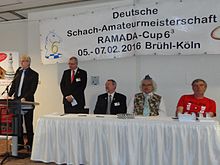
The Brühler TV 1879 (BTV) is one of the better-known and by far the largest number of members in the city.It is divided into more than twenty departments and has been particularly successful in team sports such as rugby , basketball , handball and volleyball . In addition, the departments for athletics , judo and dance sports (see dance sports in the BTV ) play a major role.
Road cycling has a long tradition in Brühl . As early as the 1940s, on the initiative of the RSC Staubwolke, the Grand Prize of the Castle and Garden City of Brühl was held in 1906 on a circuit through the city center . In addition to cycling groups from the BTV or the Brühl Police Sports Club (PSV), the sports association of the Brühl city administration and the municipal utilities has had an active cycling department since 1979. Since 1980 the cycling club RTC Radsportfreunde Brühl has stood for active mass sport on the bike. In the Schwadorf district of Brühl , it organized the annual cycling criterion Rund um Schwadorf from 2008 to 2016 , which was at times endowed with a prize from the Rhein-Erft-Bank . The cycling team of the German Childhood Cancer Foundation, founded in 2011, is also based in Brühl and takes part in the German cycling championship and national public races.
The traditional boxing club ABC Brühl 1930 , the two tennis clubs TC Fredenbruch Brühl and THC Brühl , the table tennis club TTC Vochem , the diving club Ville-Taucher Brühl , the water sports clubs Brühler Surf-Club 1976 , Faltbootfreunde Brühl and water sports enthusiasts Brühl-Heide as well as the DLRG are further representatives of active sports in Brühl.
In the tradition of the castle town - partly due to the Falkenlust hunting lodge - there are also several shooting clubs . In July, at the same time as the Margarethenkirmes, a central shooting festival takes place in the city center. Also worth mentioning is the Kahramanlar sports and educational facility, which has its own facilities and aims to promote and socially integrate migrant children.
Furthermore, there are currently nine football clubs in the city . Most are traditional clubs that can be traced back to the respective city districts or village communities, such as 1. FC Kierberg , Spvgg. Vochem or FC Viktoria 1911 Gruhlwerk , which is based in Heide . Furthermore, the 1. FSV Brühl is the first women's sports club in Brühl to focus on football. The most successful representative of football in Brühl, however, is SC Brühl 06/45 , who play in the regional league . In contrast , Blau-Weiß Brühl , which was involved in the DFB Cup , disbanded in 2009 after 60 years in the league.
Personalities
Honorary citizen
- Carl Gruhl (1862–1947), entrepreneur and founder of Karlsbad, son of Hermann Gruhl (October 4, 1912)
- Richard Bertram (1834–1920), dean and pastor to Sankt Margareta , special merits in the social and charitable field (August 29, 1919)
- Joseph Frohn (1848–1937), municipal councilor in 1898 and honorary councilor in 1910, senior teacher at the teachers' college in Brühl, special merits in the local area (July 31, 1929)
- Georg Grosser (1885–1964), from 1920 to 1955 pastor of the evangelical parish of Brühl, which reached far beyond the city limits when he took office (July 4, 1963)
- Joseph Hürten (1899–1977), over 40 years pedagogue in Brühl, twelve years of which as rector, 1932 to 1933 and 1945 to 1964 member of the city council of Brühl, eight years of which was mayor, 1961 to 1969 district administrator of the former Cologne district (June 23 1969)
- Fritz Wündisch (1910–1994), lawyer, historian and curator of the Brühl Adult Education Center (March 24, 1990)
sons and daughters of the town
- Caspar Arnold Grein (1764–1835), painter and draftsman
- Ferdinand Wurzer (1765–1844), chemist
- August Toepler (1836–1912), physicist
- Max Ernst (1891–1976), painter and sculptor
- Will Küpper (1893–1972), painter
- Leopold Bähr (1897–1945), persecuted and victim of National Socialism
- Joseph Hürten (1899–1977), mayor and honorary citizen of the city of Brühl
- Jakob Sonntag (1902–1991), writer, local historian and founder of the Brühler Heimatbund
- Heinz Burum (1905–1989), professor for trumpet and solo trumpeter
- Peter Dahr (1906–1984), pioneer of blood group research
- Friedrich Bundtzen (1910–1989), glass designer
- Aloys Lenz (1910–1976), politician (CDU) and u. a. Member of the German Bundestag
- Leo Verheugen (1913–1986), banker and founder of Brühler Bank
- Else Schmitt (1921–1995), politician (SPD) and u. a. first female district mayor in Cologne
- Josef Engel (1922–1978), historian
- Karl Josef Benz (1927–2016), church historian and liturgical scholar
- Heinz G. Zavelberg (1928–2015), politician (CDU) and u. a. President of the Federal Audit Office
- Heinz-Albert Heindrichs (* 1930), poet, draftsman and composer
- Helmut Müller-Brühl (1933–2012), conductor and initiator of the Brühl Palace Concerts at Augustusburg Palace
- Erika Reihlen (* 1936), theologian and former president of the German Evangelical Church Congress
- Georg Bollenbeck (1947–2010), German and cultural scientist
- Reiner Calmund (* 1948), soccer coach and former manager of Bayer 04 Leverkusen
- Hans Leyendecker (* 1949), journalist
- Heinz-Josef Kehr (1950–2014), football player
- Wolfgang Thönissen (* 1955), theologian
- Hans-Jörg Blondiau (* 1959), sculptor and director of the Brühl zoom cinema
- Ralph Manno (* 1964), clarinetist and university professor
- Michael Breuer (* 1965), politician (CDU) and u. a. Former North Rhine-Westphalian State Minister for Federal and European Affairs
- Daniel Dickopf (* 1970), singer and member of the a capella groups Wise Guys and Old Friends
- Patric Hemgesberg (* 1973), poet
- Gregor Golland (* 1974), politician (CDU) and u. a. Member of the North Rhine-Westphalian state parliament
- Sebastian Loth (* 1975), author and illustrator
- Ricardo Walther (* 1991), table tennis player
Personalities associated with Brühl
- Gerd Biermann (1914–2006), pediatrician, psychotherapist and founder of the Brühl Institute for Mental Hygiene
- Dietrich von Büchel (1505–1552), diplomat and secretary of Cologne Archbishop Hermann von Wied at Augustusburg Castle
- Frank Decker (* 1964), political scientist, lives in the northern part of Brühl.
- Ekkehard Drefke (1939–2015), painter and educator, lived in the Heide district.
- Philipp Ernst (1862–1942), teacher of the deaf and dumb, painter and father of Max Ernst
- Gerry Esser (* 1965), novelist, lives in the Vochem district.
- Klaus Fehling (* 1969), writer, dramaturge, director and musician, lives in Brühl.
- Carlos R. Gesualdi (* 1963), children's book author, lives in the Heide district.
- Friedrich Giesler (1793–1870), entrepreneur and founder of the Giesler brewery
- Hermann Gruhl (1834–1903), entrepreneur and founder of the Gruhlwerk
- Elisabeth Hackstein (* 1949), biologist, politician (Greens) and former head of department in Brühl
- Günter Krüger (1936–2009), painter, local historian and two-time museum initiator in Brühl
- Helga Kühn-Mengel (* 1947), politician (SPD) and u. a. Member of the German Bundestag, lives in the Kierberg district.
- Walter Leder (1947–2012), lawyer and treasurer and city director in Brühl
- Isaak von Montjoie († 1386), entrepreneur, lived not far from Augustusburg Castle.
- Jürgen Nimptsch (* 1954), actor, politician (SPD) and former Lord Mayor of Bonn, went to school in Brühl.
- Karl-Heinz Nitsche (1928–2012), architect, built numerous high-rise buildings in Brühl.
- Dieter Reick (1928–2012), painter, graphic artist and filmmaker, lived in the northern part of Brühl.
- Gerhard von Richthofen , screenwriter, television producer and documentary filmmaker, lives in the northern part of Brühl.
- Hans J. Rothkamp , local history researcher, journalist and author, lives in the Pingsdorf district.
- Paul Schneider (1931–2018), painter and advertiser, lived in the Vochem district.
- Jenny Schon (* 1942), writer and sinologist, grew up in Brühl.
- Wolfgang Streeck (* 1946), sociologist, lives in the Oststadt in Brühl.
- Marie-Luise Sobczak (* 1949), architect, local historian and city guide in Brühl, lives in the northern part of Brühl.
- Thorsten Steffens (* 1984), writer and teacher, lives in the Badorf district.
- Marco Takis , presenter and magician, lives in the Vochem district.
- Elisabeth Treskow (1898–1992), goldsmith and u. a. Creator of the German championship trophy , lived in the northern part of Brühl.
- Günter Verheugen (* 1944), politician (FDP, SPD) and u. a. Vice President of the European Commission , son of Leo Verheugen , grew up in Brühl.
- Eva J. Wieczorek (* 1951), painter, runs a studio in Brühl.
literature
- Paul Clemen: The district of Cologne . In: The art monuments of the Rhine province. Vol. 4, Düsseldorf 1897, reprinted. 1983, ISBN 3-590-32118-0 (Badorf p. 13 f., Brühl p. 69 ff., Kierberg p. 157 f., Pingsdorf p. 16 f., Schwadorf p. 177 and Vochem p. 186 ff. ).
- Robert W. Rosellen: History of the parishes of the deanery Brühl. Cologne 1887, without ISBN.
- Jakob Sonntag: Brühl. History and stories. In: Series of publications on the history of Brühl. Vol. 2, Brühl 1976, ISBN 3-921300-01-0 .
- Jakob Sonntag: Altbrühler picture book. In: Series of publications on the history of Brühl. Vol. 3, Gummersbach 1980, ISBN 3-88265-051-6 .
- Bernhard Münch u. Marlies Fey-Bursch: Brühl in old views. Zaltbommel 1996, ISBN 90-288-6333-8 .
- Gerd Biegel u. Gerd Baums: Brühl today. Brühl 1979, DNB 800697367 .
- Wolfgang Drösser: Brühl. History, pictures, facts, connections. Erftstadt 2005, ISBN 3-921300-05-3 .
- Hans J. Rothkamp: Augustusburg Castle and Park. Erfurt 2005, ISBN 3-89702-926-X .
- Hans J. Rothkamp: Old Brühl company and business. Erfurt 2006, ISBN 3-86680-057-6 .
- Hans J. Rothkamp: Brühler suburbs. Erfurt 2008, ISBN 978-3-86680-397-8 .
- Hans J. Rothkamp: In Alt-Brühler streets. A walk. Erfurt 2010, ISBN 978-3-86680-623-8 .
- Karl H. Oleszowsky: From the Brühler Pavilion via the Benediktusheim to the Max Ernst Museum. Brühl 2007, ISBN 978-3-00-022227-6 .
- Hermann Schmidt: Brühl. An economic and socio-geographic study with special consideration of the structural change after the extinction of the lignite industry . Cologne 1961, without ISBN.
- Jenny Schon: Rhenish Rondeau. Stories, poems . Berlin 2012, ISBN 978-3-86465-010-9 (with a preface by Günter Verheugen).
Web links
- www.bruehl-info.de - Privately run website with interesting facts about Brühl
- www.altes-bruehl.de - Privately run website of the Brühl interest group
Individual evidence
- ↑ Population of the municipalities of North Rhine-Westphalia on December 31, 2019 - update of the population based on the census of May 9, 2011. State Office for Information and Technology North Rhine-Westphalia (IT.NRW), accessed on June 17, 2020 . ( Help on this )
- ↑ Number of residents of the city of Brühl broken down by district as of December 31, 2019
- ↑ Federal Research Institute for Regional Studies and Regional Planning (ed.); Ewald Glässer (arrangement): The natural spatial units on sheet 122/123 . Self-published, Bonn-Bad Godesberg 1978, ISBN 3-87994-328-1 , p. 32. (= Geographical Land Survey 1: 200,000. Natural division of Germany )
- ↑ Annual statistics of the city of Brühl 2014/2015 (PDF), p. 4
- ↑ For information on annual precipitation cf. Climate diagrams of North Rhine-Westphalia in Wikimedia Commons .
- ↑ Paul Clemen: Die Kunstdenkmäler der Rheinprovinz, der Landkreis Köln p. 13 f., With reference to: Annals of the historical association for the Lower Rhine, XXXVII p. 63.
- ^ Wolfgang Drösser: Brühl. History, pictures, facts, connections. P. 14.
- ↑ Fund template of the two graves from the Römerstrasse by Waldemar Haberey, Bonner Jahrbücher 162, 1962, pp. 397–406. See Wolfgang Drösser: Brühl. History, pictures, facts, connections. P. 15.
- ↑ On the graves in Sankt-Albert-Straße cf. Raymund Gottschalk: Late Roman graves in the area around Cologne . Rhenish excavations 71. Darmstadt 2015. especially pp. 293–296 with plates 20–23.
- ^ Robert W. Rosellen: History of the parishes of the deanery Brühl. Cologne 1887, p. 82.
- ^ Heinrich Gottfried Philipp Gengler: Regesta and documents on the constitutional and legal history of German cities in the Middle Ages. Erlangen 1863, p. 412 ( digitized in the Google book search).
- ^ Robert W. Rosellen: History of the parishes of the deanery Brühl. Cologne 1887, p. 93.
- ↑ Rolf Brockschmidt: Pogrom Night 1938 How an SA man boasts of the destruction of the Brühl synagogue. In: Der Tagesspiegel . November 7, 2018, accessed October 3, 2019 .
- ^ Georg Grosser: Evangelical community life in the Cologne region. Verlag der Löwe, Cologne 1958, p. 9 ff.
- ↑ Website of the Johanneskirche, City of Brühl ( Memento of the original from January 10, 2016 in the Internet Archive ) Info: The archive link was inserted automatically and has not yet been checked. Please check the original and archive link according to the instructions and then remove this notice. ; accessed on January 10, 2016.
- ↑ orthodox-bruehl.de
- ↑ Christina Hustedt: Ring of honor for Archpriest Miron. March 29, 2015, accessed September 5, 2015 .
- ↑ bruehlermoschee.de
- ↑ Mosques in Brühl
- ↑ Main State Archives Düsseldorf, Best. Reg. Cologne, special files concerning the organization of the Synagogengem. in the district of Cologne, quoted from Lothar and Maria Sterck: History of a half-timbered house in Alt-Hürth. In: Hürther Heimat. Volume 6, p. 64.
- ↑ According to the notes of the dean Berrisch, then in the parish archives. Quoted from Robert W. Rosellen: History of the parishes of the deanery Brühl. Cologne 1887, p. 101.
- ↑ Website Brühl - City Council Election 2014 ( Memento of the original from February 21, 2015 in the Internet Archive ) Info: The archive link was inserted automatically and has not yet been checked. Please check the original and archive link according to the instructions and then remove this notice.
- ↑ Freizeit , City of Brühl
- ↑ Brühl's water tower should shine in summer , Kölner Stadt-Anzeiger , March 14, 2017
- ↑ bruehl.de ( Memento of the original from May 15, 2011 in the Internet Archive ) Info: The archive link was inserted automatically and has not yet been checked. Please check the original and archive link according to the instructions and then remove this notice.
- ^ Rhein-Erft-Kreis (Ed.): Museums and private collections on the Rhine and Erft. 2nd Edition. 2009, p. 18 f.
- ↑ Michael Greuel: Fire in Brühl. Museum closed for months. In: Kölner Stadt-Anzeiger (KStA). Brühl, January 31, 2014, accessed February 1, 2014.
- ↑ Bernd Imgrund , Nina Osmers : 111 places in the Cologne area that you have to see. Verlag Emons, Cologne 2010, ISBN 978-3-89705-777-7 , location 27.
- ^ Rhein-Erft-Kreis (Ed.): Museums and private collections on the Rhine and Erft. 2nd Edition. 2009, p. 16 f.
- ↑ Opening of a second track - replacement traffic on line 18 in Bornheim. April 2, 2019, accessed May 30, 2019 .
- ^ Two-track expansion of line 18 (2) - City of Brühl. Retrieved May 30, 2019 .
- ↑ Timetables. Retrieved May 30, 2019 .
- ↑ Wolfgang Schaaf: 2016 no race in Brühl-Schwadorf. (No longer available online.) In: www.challenge-magazin.com. Archived from the original on February 6, 2016 ; accessed on February 6, 2016 . Info: The archive link was inserted automatically and has not yet been checked. Please check the original and archive link according to the instructions and then remove this notice.

